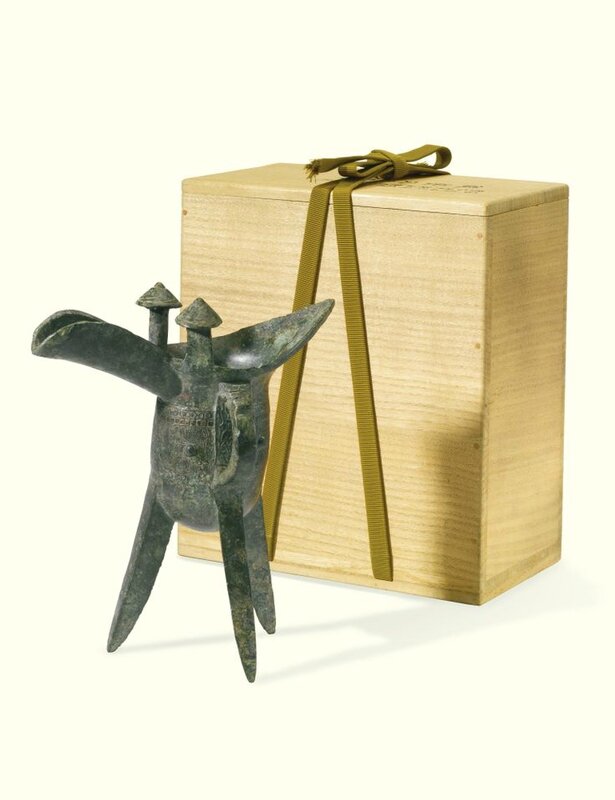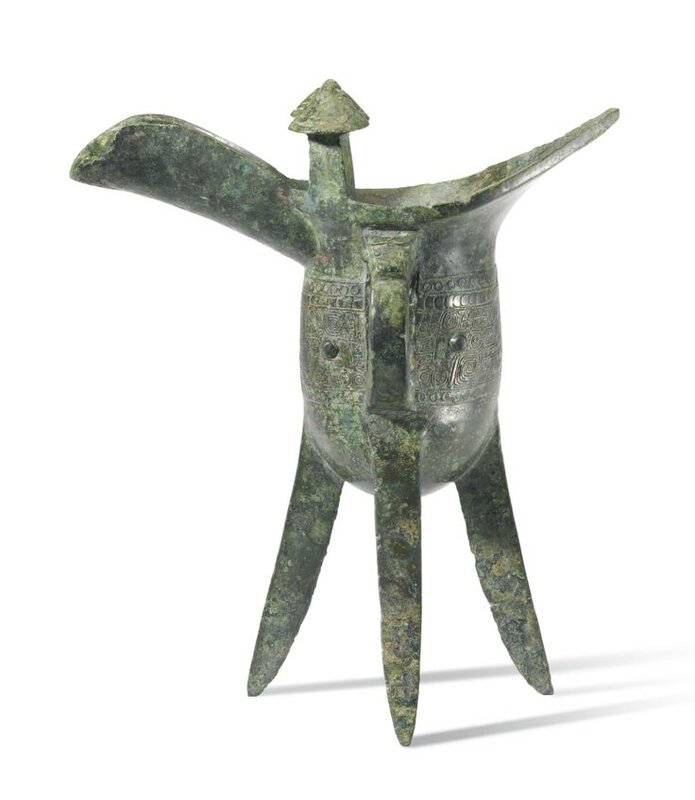The Rong Fu Jue. A bronze ritual wine vessel. Late Shang Dynasty, 13th-11th century BC.
The Rong Fu Jue. A bronze ritual wine vessel. Late Shang Dynasty, 13th-11th century BC. Photo Sotheby's
The deep 'U'-shaped body supported on three splayed blade-like legs, decorated on each side with a frieze of taotie mask with prominent eyes on a fine leiwen ground, below a band of scale motifs between two borders of circles, centered by a vertical flange and a loop handle issuing from a bovine head, the long spout and pointed tail forming the rim, surmounted by a pair of posts capped by conical tops with sunken whorl pattern, a two-character inscription beneath the handle, the surface with an olive green patina. Height 8 in., 20 cm. Estimation 30,000 — 50,000 USD
Provenance: Collection of Jiang Deliang (1752-1793), probably.
Collection of Wu Dacheng (1835-1902).
Private Japanese collection.
Litterature: Ruan Yuan, Jiguzhai zhongdingyiqi kuanzhi, (Archaic Bronzes Inscriptions in the Jiguzhai Studio), 1804, vol. 2, p. 7.
Wu Shifen, Meigulu jinwen, (The Records of Pursuing Antiquity: Archaic Bronze Inscriptions), 1850, vol. 1.1, p. 7.
Fang Junyi, Zhuiyizhai yiqikuanzhi kaoshi, (Interpretations of Archaic Bronze Inscriptions in the Zhuiyizhai Studio), 1899, vol. 19, p. 31.
Luo Zhenyu, Yinwencun, (Surviving Writings from the Yin Dynasty), 1917, vol. 2, p. 5.
Luo Zhenyu, Sandai jijin wencun, (Surviving Writings from the Xia, Shang, and Zhou Dynasties), 1936, vol. 16, p. 16.
Yan Yiping, Jinwen Zongji, (Corpus of Bronze Inscriptions), Taipei, 1983, no. 3884.
The Institute of Archaeology, Chinese Academy of Social Sciences, Yinzhou jinwen jicheng, (Compendium of Yin and Zhou Bronze Inscriptions), Beijing, 1984, vol. 14, p. 202, no. 8567.
Wu Zhenfeng, Shangzhou qingtongqi mingwen ji tuxiang jicheng, (Compendium of Inscriptions and Images of Bronzes from the Shang and Zhou Dynasties), Shanghai, 2012, vol. 16, p. 82, no. 7877.
Zhou Ya, Kezhai jigutu jianzhu, (The Annotations on the Illustration of Kezhai’s [Wu Dacheng] Collected Antiquities), Shanghai, 2012, p. 24.
The inscription on this jue was first published by Ruan Yuan (1764-1894) in the Jiguzhai zhongdingyiqi kuanzhi, (Archaic Bronze Inscriptions in the Jiguzhai Studio). According to a later publication Meigulu, the inscription in Ruan Yuan's book was transcribed from a copy made by Jiang Deliang (1752-1793). It is possible that this jue vessel was once owned by Jiang Deliang who had an extensive collection of paintings, calligraphy, stelae and bronzes. In the late Qing period, this bronze jue vessel entered the collection of Wu Dacheng (1835-1902). Despite his achievements in politics, Wu Dacheng was most renowned for his scholarship on bronze inscriptions and ancient objects. An ink rubbing of the present vessel and its inscription were included in Kezhai Jigutu, (The Illustration of Kezhai’s [Wu Dacheng] Collected Antiquities), now in the Shanghai Museum and published by Zhou Ya in the Kezhai jigutu jianzhu, (The Annotations on the Illustration of Kezhai’s [Wu Dacheng] Collected Antiquities), Shanghai, 2012, p. 24a.
In many publications, the first character of the inscription on this jue vessel has been mistakenly translated as yan due to the difficulty of discerning the ink-rubbing of the inscription underneath the handle, on which the character fu is also omitted. The first character is actually a clan sign reading rong that comprises a fire flame on top and a tripod at the bottom. The difference between rong and yan is that the former has a three-pronged top denoting the fire flame, which was omitted in all rubbings and drawings in old illustrations. A jue vessel bearing the clan sign rong excavated from Sufutun, Qingzhou city, Shandong province is illustrated in Wu Zhenfeng, Shangzhou qingtongqi mingwen ji tuxiang jicheng, (Compendium of Inscriptions and Images of Bronzes from the Shang and Zhou Dynasties), Shanghai, 2012, vol. 14, p. 37, no.6434.
The box for this lot is inscribed with a research note written by Professor Matsumaru Michio, dated 2000.
Wu Dacheng, was born in Wuxian (Suzhou) in 1835. He was a follower of the important politician and diplomat Li Hongzhang (1823-1901), and served as a high ranking official at the Manchu Court, but his real passion was in traditional arts and collecting. He named his studio “Ke Zhai”, because he once owned a Zhou dynasty bronze vessel Ke Ding; he published his collection in Kezhai jigulu, (Kezhai’s [Wu Dacheng] Records of Collecting Antiquities). He was also an accomplished calligrapher and amateur painter.
Sotheby's. Archaic Bronzes and the Wu Dacheng Jijintu Scroll. New York. 18 mars 2014 - www.sothebys.com

/https%3A%2F%2Fprofilepics.canalblog.com%2Fprofilepics%2F1%2F0%2F100183.jpg)
/https%3A%2F%2Fstorage.canalblog.com%2F03%2F02%2F119589%2F96711876_o.jpg)
/https%3A%2F%2Fstorage.canalblog.com%2F11%2F31%2F119589%2F94773502_o.jpg)
/https%3A%2F%2Fstorage.canalblog.com%2F20%2F83%2F119589%2F94772815_o.jpg)
/https%3A%2F%2Fstorage.canalblog.com%2F26%2F72%2F119589%2F75604929_o.jpg)
/https%3A%2F%2Fstorage.canalblog.com%2F59%2F60%2F119589%2F26458628_o.jpg)








/image%2F1371349%2F20240406%2Fob_b23648_434058570-1644317966338216-88086167391.jpg)
/image%2F1371349%2F20240403%2Fob_6d5ae7_dp-28103-001.jpg)
/image%2F1371349%2F20240229%2Fob_8f31f9_431013694-1625286614908018-33034430839.jpg)
/http%3A%2F%2Fstorage.canalblog.com%2F79%2F20%2F119589%2F129837997_o.jpg)